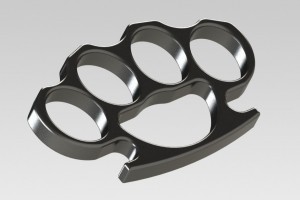Facial Sufficiency of Misdemeanor Accusatory Instrument: Plain Meaning Provides Sufficient Notice of Charges
People v. Aragon
New York Court of Appeals
2016 NY Slip Op 07104
Decided on November 1, 2016
 Issue: Whether the misdemeanor accusatory instrument alleging that defendant unlawfully possessed “brass metal knuckles” was facially sufficient.
Issue: Whether the misdemeanor accusatory instrument alleging that defendant unlawfully possessed “brass metal knuckles” was facially sufficient.
Holding: The New York Court of Appeals held that the accusatory instrument was facially sufficient.
Facts: A police officer stopped the defendant and recovered brass metal knuckles from the defendant’s right pocket. The defendant argued that the accusatory instrument was facially insufficient and moved to dismiss. After the Criminal Court denied the motion, the defendant pleaded guilty to disorderly conduct and waived prosecution by information. The defendant appealed on the previous argument that the accusatory instrument was facially insufficient. The Appellate Term affirmed and held that the allegations in the accusatory instrument established reasonable cause for the defendant to be guilty of the charge because the factual allegations were sufficiently evidentiary.
Legal Analysis: Criminal Procedure Law 100.15 (3) provides that a misdemeanor complaint “must contain a statement of the complainant alleging facts of an evidentiary character supporting or tending to support the charges,” and CPL 100.40 [4] [b] provides that the complaint must also “provide reasonable cause to believe that the defendant committed the offense charged.” The defendant argued he was not sufficiently notified of the charges because the accusatory instrument stated in the complaint was facially insufficient and did not satisfy due process and double jeopardy demands as in People v. Dreyden (People v. Dreyden, 15 NY3d 100, 103 [2010]).
Under Penal Law 265.01, “metal k nuckles” is listed among weapons that constitute a person to be guilty of a weapon possession in the fourth degree. However, Penal Law 265.00, which provides definitions of the listed weapons, does not provide a definition of “metal knuckles.” The New York Court of Appeals sought to interpret the most obvious and natural definition by referring to Black’s Law Dictionary, which defines “brass knuckles” as a “piece of metal designed to fit over the fingers as a weapon for use in a fistfight.” Although Black’s Law Dictionary defines “brass knuckles” and not “metal knuckles,” the Court of Appeals reasoned that similar characteristics are commonly recognized for both objects. Both terms describe “a metal object with multiple holes, through which an individual places his or her fingers so that a metal bar rests atop the individual’s knuckles” (People v. Aragon, 2016 NY Slip Op 07104, Court of Appeals, decided on November 1, 2016).
nuckles” is listed among weapons that constitute a person to be guilty of a weapon possession in the fourth degree. However, Penal Law 265.00, which provides definitions of the listed weapons, does not provide a definition of “metal knuckles.” The New York Court of Appeals sought to interpret the most obvious and natural definition by referring to Black’s Law Dictionary, which defines “brass knuckles” as a “piece of metal designed to fit over the fingers as a weapon for use in a fistfight.” Although Black’s Law Dictionary defines “brass knuckles” and not “metal knuckles,” the Court of Appeals reasoned that similar characteristics are commonly recognized for both objects. Both terms describe “a metal object with multiple holes, through which an individual places his or her fingers so that a metal bar rests atop the individual’s knuckles” (People v. Aragon, 2016 NY Slip Op 07104, Court of Appeals, decided on November 1, 2016).
The defendant argued that because jewelry, luggage tags, cell phone cases, and other items can provide the same use as that of “brass knuckles,” the accusatory instrument was insufficient. However, since these items are not included in the per se weapons listed under Penal Law 265.01 (1), the defendant’s argument was rejected. The items referred to by the defendant were not reasonably defined as weapons, but the defendant, rather, attempted to read into exceedingly technical definitions of accusatory instruments.
“A reasonable, not overly technical reading” of the accusatory instrument here satisfies the Court of Appeal’s sufficiency standard (Konieczny, 2 NY3d at 576). It supplied “defendant with sufficient notice of the charged crime to satisfy the demands of due process and double jeopardy” (Dreyden,15 NY3d at 103). . The term “brass metal knuckles” gave the defendant a clear description of the object recovered from his pocket. Under the common and natural definition of the term, as well as the dictionary definition, defendant was adequately informed of the charge against him.
Given that the accusatory instrument satisfied the sufficiency standard of the New York Court of Appeals, the defendant was given adequate notice of the crime with which he was charged. It was clear that the defendant possessed a per se weapon (“brass metal knuckles” under Penal Law 265.01 (1). The Court of Appeals held that the defendant was sufficiently informed of the charge against him since a commonly understood definition and dictionary definition of “brass metal knuckles” exists.
The defendant argued that, at the time of his arrest, the police officer failed to explain how he concluded that the object in the defendant’s possession identified as “brass knuckles.” In People v. Dreyden the Court of Appeals stated that an “arresting officer should, at the very least, explain briefly, with reference to his training and experience, how he or she formed the belief that the object observed in defendant’s possession was a” gravity knife (15 NY3d at 204). In the more recent decision in People v Sans (26 NY3d 13 [2015]), which also involved a gravity knife, the Court of Appeals specified that the arresting officer tested the knife to conclude that it was, indeed, a gravity knife. By performing operations like opening and closing the knife, the arresting officer was able to define the retrieved weapon as a “gravity knife.” However, since the instant case involved an object (“metal knuckles”) in which such operations were not possible, it was only necessary for the arresting officer to look at the object to determine whether or not its characteristics aligned with those of metal knuckles. The Court of Appeals, like the Appellate Term, held that the order should be affirmed.
